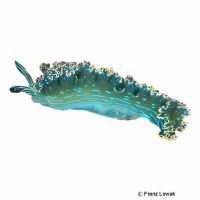Diomede's Sapsucker (Elysia diomedea)
| Diomede's Sapsucker Elysia diomedea | |
|---|---|
| Name | Diomede's Sapsucker |
| Name Lat. | Elysia diomedea |
| Family | Plakobranchidae |
| Family lat. | Plakobranchidae |
| Order | Sacoglossans |
| Order lat. | Sacoglossa |
| Origin | Eastern Pacific |
| Diet | Herbivore |
| pH | 8.1-8.4 |
| Hardness | 8-10 °KH |
| Lighting | High |
| Current | Moderate |
| Behavior | Peaceful |
| Keeping | Individual |
| Care Level | Difficult |
| Life Span | N/A |
| Protection | No |
| Metric Units | |
| Size | 5 cm |
| Temperature | 20-27 °C |
| Salinity | 33-36 ‰ |
| Aquarium | 200 l |
| US Units | |
| Size | 2" |
| Temperature | 68-81 °F |
| Salinity | 1.020-1.025 sg |
| Aquarium | 50 gal |
Distribution and habitat
Elysia diomedea, a nudibranch, is native to the Pacific coast of Central America, from the Gulf of Panama to the Gulf of California. They live mainly in the sunny shallow waters of the intertidal zone with abundant algae and sea grasses.
Maintenance
They require an aquarium with a reef structure overgrown with algae, a high light intensity and a moderate, alternating current. Only lime-rich, heavy metal-free substrates may be used as substrate
To ensure water quality, filters, skimmers and heaters are necessary, as well as pumps to simulate tides, swells and bottom currents. It is recommended that live stones be used to set up the aquarium. The bacteria living in the porous stones act as a biological filter. The lighting must correspond to the species-appropriate day-night rhythm of the animals
| Salinity: 33-36 ‰ | pH value: 8.1-8.4 |
| Carbonate hardness: 8-10 °KH | Nitrate content: 2-8 mg/l |
| calcium content: 420-450 mg/l | Nitrite content: 0.0-0.05 mg/l |
| Magnesium content: 1.250-1.350 mg/l | phosphate content: 0.01-0.1 mg/l |
Regular addition of trace elements, especially strontium, is recommended. For salinity, an average value should be aimed for, which may only vary slightly by +/- 0.5 ‰. Ammonia and ammonium must not be measurable. Special attention shall be paid to consistently good water quality and water values.
Diet
They are food specialists that feed on algae, not eating the algae but tearing it open with their radula (rasping tongue) and sucking out the chloroplasts of the algae (sap suckers). The chloroplasts are stored in the skin and other organs and together with sunlight the velvet snails can gain energy through photosynthesis. Due to this way of feeding they are also called "Solar Powered Sea Slugs"
It is important to have a well acclimated aquarium with abundant algae growth, although not every type of algae is accepted.
Behaviour and compatibility
They are loners that can be well maintained in a reef aquarium with fish and invertebrates if there are enough hiding places. Since they secrete a defensive secretion for defense, they are spared by fish and shrimp.
Reproduction and breeding
No external sexual characteristics are known. They lay spawning cords that form a shallow spiral. The very small eggs hatch into buoyant larvae (veliger larvae), which live as part of the zooplankton before settling on the sea floor as fully developed juvenile snails after metamorphosis
There are no known reports of successful reproduction in the aquarium.
Important
Their different coloration, from dark to light green, depends on the type of algae that serves as their food.
The additional illumination with actinic light (short-wave, violet-blue light) is very beneficial for their growth (photosynthesis)
If different species are kept together, make sure that fish and invertebrates match each other in terms of water quality and temperature requirements and their social behavior, and that the setup meets the ecological needs of all species kept together. When placing them in the aquarium, they must be acclimated slowly to the water in the aquarium.
Further literature can be found in your pet store.
References
Text: petdata; Image: Franz Lowak
Source: ENGELMANN & LANGE (2011): Zootierhaltung - Tiere in menschlicher Obhut: Wirbellose, Verlag Harri Deutsch; ERHARDT & MOOSLEITNER (1997): Meerwasser Atlas Bd. 2, Mergus Verlag
